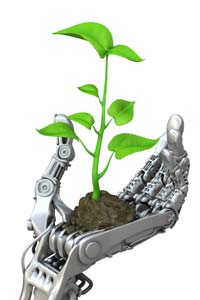By Devin Partida

STEM educators have numerous tools at their disposal to keep students engaged with technology. It’s necessary in a tech-driven world, where students crave modern interactivity to maintain their attention and process concepts. Robotics is steadily becoming commonplace in classrooms as incorporation simplifies complex ideas and promotes sustainability to youth.
What can robotics offer STEM educators wanting to convey sustainable lessons to their students, and how can robots make a greener planet?
How Teachers Create Meaningful Robotics Programs
Teachers must make plans for their robotics program that are budget-friendly and eco-conscious. Instructors may need additional education or training so they can communicate concepts constructively. They must also convince administrators to support and fund the project, which should be simple — a study showed 80% of respondents agreed that robotics increased instructional value.
Planning is critical because it will increase the return on investment and ensure programs closely align with the goals of a sustainable curriculum. STEM educators should choose one or just a few priorities for their program, as covering every environmentalist topic with robots is not feasible.
Today’s workforce needs more green talent to meet the demands of sustainable legislation bolstering sustainable companies, like overhauling recycling infrastructure. Making a note of the most desperate sectors would be a productive way to motivate a sustainable robotics program.
Demand for green jobs increases daily, and education must concentrate on climate-focused skills to fill labor gaps. Sectors like education, construction and public safety are a few of the most in-need industries for green expertise and vacant job offerings. Bolstering these fields creates better relationships between educational institutions and businesses seeking professionals — and it saves the planet. The most desirable skills employers want include:
Environmental remediation ,Ecosystem mamagnement, Renewable energy generation
Environmental auditing.
STEM educators can seek robotics kits that work with current numbers to provide the most value to their nation for their financial investment. Refer to modern sector-specific technology so student interactivity accurately reflects real-life robotics applications.
How Robots Promote Sustainability
From startups to well-established enterprises, everyone is engineering robots to perform tasks that help the planet. Even popular media, like Pixar’s “Wall-E,” demonstrates how robots aid in positive climate change and recycling efforts. Here are some other recent STEM endeavors of environmental advocates:
- Plantoid Project: This company created a robot that grows like a planet to help humans understand more about how pollutants affect development.
- Hippo Harvest: A startup growing produce in climate-controlled greenhouses uses AI-powered robots to administer water smartly and release helpful insects.
- Skygrow: Their Growbot machine plants native trees to curb rapid deforestation.
- EcoRobotix: A mobile robot decreases pesticide use with more targeted administration, minimizing cross-contamination to other ecosystems.
- Jellyfishbot: Maker IADYS fashioned an autonomous water vacuum for pollutants.
- Apple: The tech giant uses robots to expedite iPhone recycling.
In manufacturing and agriculture, robots can minimize energy expenditure, reduce waste, decrease water use and promote more careful environmental interactivity. These all increase automation and reduce costs and stress on companies and staff, making sustainability more appealing to corporations and governments.
Suppose educators instruct students to view robotics in sustainability as the norm. In that case, it’s more likely that mindset will translate to corporations making green goals more enticing, like instilling more rigorous corporate social responsibility values.
They can also educate students on environmental topics. Virtual robot assistants could answer questions or provide augmented reality simulations to help students understand complicated ecological processes. With some propellers, lines of code and climate-driven motivation, people can program robots to clean the earth and educate the masses.
How STEM Educators Create Robotics Lesson Plans
Depending on students’ ages, educators should begin by teaching robotics basics before implementing the sustainability lens. Going over basic structures like gears and motors will help students conceptualize how they can manipulate robots to achieve eco-friendly tasks. Higher-level students may want to engage with blueprints or learning code for programming. Choose topics at your discretion based on the student body’s capabilities.
Whatever path an educator takes, they can use robotics kits to simulate sustainable development and industry. They could use Legos to make a mock production line more energy efficient or learn how to harvest crops in the least damaging way. Students could also make constructions focused on maneuverability in specific ecosystems, like robots collecting water samples while staying afloat or robots that repair electric vehicles regardless of the maker.
Another priority teachers can assert is monitoring. Much of the sustainability sector is collecting data to discover process improvements, so instructing students on sensor technology and how robots can measure and store accurate data on metrics like air quality will expand their minds on what environmental robotics can encompass.
After learning the mechanics and applications, STEM educators can teach robotics applications alongside environmental critical thinking. Students must question how they can improve on existing technology or what needs the world has that robotics could fill. Imagination is as vital in sustainability as practicality. Ask students how robots could help the success of sustainable development goals, like creating sustainable cities or improving water sanitation.
Robotics lesson plans need to encourage mental work as heavily as hands-on practical education for continued advancement in the sustainability field.
Blending Robotics and Nature
While robots and nature are disparate concepts, STEM educators can demonstrate their interconnectivity through quality robotics education. Using robots for environmental programs could encourage the next generation of engineers, computer programmers or scientists to embrace the limitless ingenuity of technology to promote sustainable initiatives.
About the Author Devin@rehack.com

